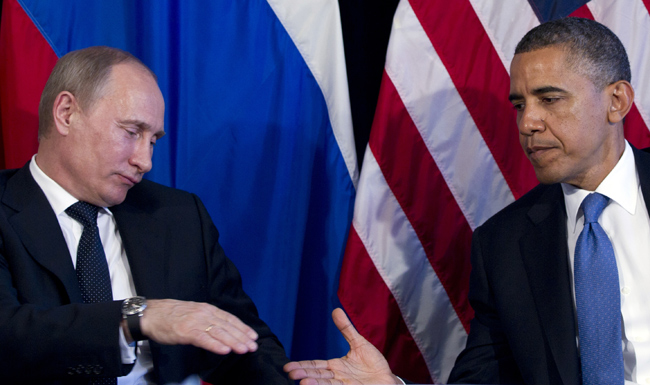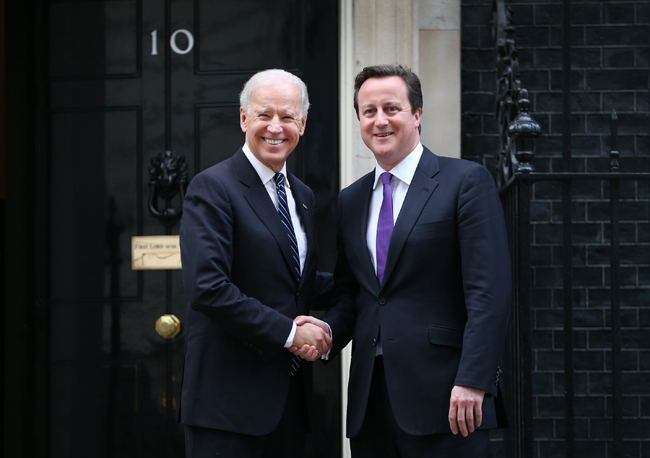The most powerful handshake in the world
A few techniques for dominating with your hands

We've all been victims of a terrible handshake. Maybe it's a death-grip where you feel like you're shaking hands with a lobster. Maybe it's a limp, lifeless shake, like you're suddenly wagging a fern. Either way, if you're meeting someone for the first time, a bad shake can leave a lasting, negative impression — especially in the world of business.
It's almost become a truism, but that's because it's true: A great handshake can go a long way in earning respect from new colleagues or impressing a potential employer. People judge and are judged based on body language and physical social interactions.
So how do you get the most out of your handshake? The Definitive Book of Body Language, by Barbara and Allan Pease, offers some tips.
The Week
Escape your echo chamber. Get the facts behind the news, plus analysis from multiple perspectives.

Sign up for The Week's Free Newsletters
From our morning news briefing to a weekly Good News Newsletter, get the best of The Week delivered directly to your inbox.
From our morning news briefing to a weekly Good News Newsletter, get the best of The Week delivered directly to your inbox.
Mainly, the Peases point out three handshake techniques that communicate dominance: the "upper-hand," the "double-hander," and the "left-side advantage."
The "upper-hand" simply refers to the person on top whose palm is facing slightly down for the shake. According to Pease, using the upper-hand "communicates that you want to take control of the encounter." Here you can see Vladimir Putin going for the "upper-hand" with Obama:

The same is true in reverse — a palm-up handshake (or the "lower-hand") communicates submissiveness, which "can be effective if you want to give the other person control or allow him to feel that he is in charge of the situation."
The "left-side-advantage" is a technique solely for handshake photos. According to the Peases, the person on the left side of the photo who crosses his arm over his body for the shake appears more powerful than the person on the right, with the open body and bent elbow. Check out America's vice president pull off that move with England's prime minister.
A free daily email with the biggest news stories of the day – and the best features from TheWeek.com

The "double-hander," unlike the "upper-hand" and "left-side advantage," communicates dominance through intimacy. The technique can counteract power-players using either of the first two techniques.
The person giving the double-hander wraps both palms firmly around the receiver's hand, affectionately increasing contact. It also "gives control over the receiver by restricting his right hand," the Peases say. This move can recover some control from the right side of a photo, or be used to straighten out an "upper-hand."
The farther the initiator moves his left hand up the receivers arm, the more intimate and powerful the shake. "The initiator is attempting to show an intimate connection with the receiver, while, at the same time, attempting to control their movement," write the Peases. Check Germany's president getting a double-hander from the pope:

But be careful: The Peases warn not to use this move on a stranger. "The double-hander is like a miniature hug, and is acceptable only in circumstances where a hug could also be acceptable," they write.
So what is the world's most powerful handshake? An upper-hand double-hander with a left-side advantage?
Actually, no. A blanket exertion of dominance is not the most powerful choice for every situation. In fact, if you're a new intern at a company with a strong hierarchy and you greet the head honcho with this triple-whammy, she'll probably think you're overly confident, even rude.
So unless your goal is to intimidate, go for a vertical shake — one that shows respect and equality with the person you're greeting. Make eye contact, repeat the person's name, and base the strength of your grip on your partner's. If he's crunching your bones, step it up; if he's limp and lifeless, be gentle.
Don't create one handshake and use it on everyone, the way you would a signature. Shake hands like you'd kiss: With your attention on finding a balance with the receiver. Making a new acquaintance feel comfortable is key to a good first impression.
And if you do find yourself in a paw-lock with a handshake bully, use these tools to turn the dial back to the middle and demand respect.
Carmel Lobello is the business editor at TheWeek.com. Previously, she was an editor at DeathandTaxesMag.com.
-
 A luxury walking tour in Western Australia
A luxury walking tour in Western AustraliaThe Week Recommends Walk through an ‘ancient forest’ and listen to the ‘gentle hushing’ of the upper canopy
-
 What Nick Fuentes and the Groypers want
What Nick Fuentes and the Groypers wantThe Explainer White supremacism has a new face in the US: a clean-cut 27-year-old with a vast social media following
-
 5 highly amusing cartoons about rising health insurance premiums
5 highly amusing cartoons about rising health insurance premiumsCartoon Artists take on the ACA, Christmas road hazards, and more